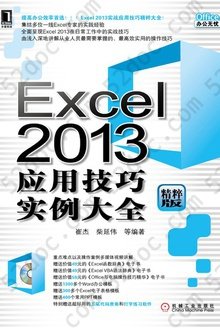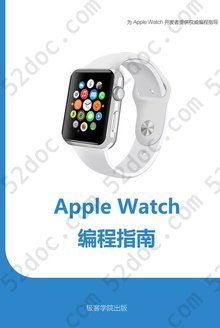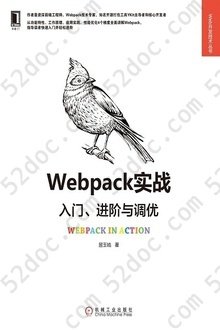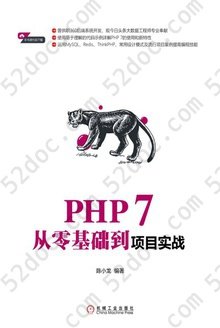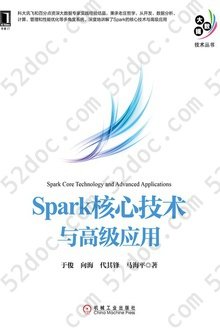注重体验与质量的电子书资源下载网站
分类于: 互联网 计算机基础
简介
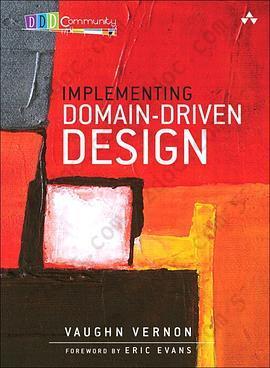
Implementing Domain-Driven Design 豆 8.4分
资源最后更新于 2020-08-23 16:19:38
作者:Vaughn Vernon
出版社:Addison-Wesley Professional
出版日期:2013-01
ISBN:9780321834577
文件格式: pdf
标签: 领域驱动设计 DDD 架构 计算机 软件工程 编程 基础理论 programming
简介· · · · · ·
"For software developers of all experience levels looking to improve their results, and design and implement domain-driven enterprise applications consistently with the best current state of professional practice, Implementing Domain-Driven Design will impart a treasure trove of knowledge hard won within the DDD and enterprise application architecture communities over the last ...
目录
Foreword xvii
Preface xix
Acknowledgments xxix
About the Author xxxiii
Guide to This Book xxxv
Chapter 1: Getting Started with DDD 1
Can I DDD? 2
Why You Should Do DDD 6
How to Do DDD 20
The Business Value of Using DDD 25
The Challenges of Applying DDD 29
Fiction, with Bucketfuls of Reality 38
Wrap-Up 41
Chapter 2: Domains, Subdomains, and Bounded Contexts 43
Big Picture 43
Why Strategic Design Is So Incredibly Essential 53
Real-World Domains and Subdomains 56
Making Sense of Bounded Contexts 62
Sample Contexts 72
Wrap-Up 84
Chapter 3: Context Maps 87
Why Context Maps Are So Essential 87
Wrap-Up 111
Chapter 4: Architecture 113
Interviewing the Successful CIO 114
Layers 119
Hexagonal or Ports and Adapters 125
Service-Oriented 130
Representational State Transfer–REST 133
Command-Query Responsibility Segregation, or CQRS 138
Event-Driven Architecture 147
Data Fabric and Grid-Based Distributed Computing 163
Wrap-Up 168
Chapter 5: Entities 171
Why We Use Entities 171
Unique Identity 173
Discovering Entities and Their Intrinsic Characteristics 191
Wrap-Up 217
Chapter 6: Value Objects 219
Value Characteristics 221
Integrate with Minimalism 232
Standard Types Expressed as Values 234
Testing Value Objects 239
Implementation 243
Persisting Value Objects 248
Wrap-Up 263
Chapter 7: Services 265
What a Domain Service Is (but First, What It Is Not) 267
Make Sure You Need a Service 268
Modeling a Service in the Domain 272
Testing Services 281
Wrap-Up 284
Chapter 8: Domain Events 285
The When and Why of Domain Events 285
Modeling Events 288
Publishing Events from the Domain Model 296
Spreading the News to Remote Bounded Contexts 303
Event Store 307
Architectural Styles for Forwarding Stored Events 312
Implementation 318
Wrap-Up 331
Chapter 9: Modules 333
Designing with Modules 333
Basic Module Naming Conventions 336
Module Naming Conventions for the Model 337
Modules of the Agile Project Management Context 340
Modules in Other Layers 343
Module before Bounded Context 344
Wrap-Up 345
Chapter 10: Aggregates 347
Using Aggregates in the Scrum Core Domain 348
Rule: Model True Invariants in Consistency Boundaries 353
Rule: Design Small Aggregates 355
Rule: Reference Other Aggregates by Identity 359
Rule: Use Eventual Consistency Outside the Boundary 364
Reasons to Break the Rules 367
Gaining Insight through Discovery 370
Implementation 380
Wrap-Up 388
Chapter 11: Factories 389
Factories in the Domain Model 389
Factory Method on Aggregate Root 391
Factory on Service 397
Wrap-Up 400
Chapter 12: Repositories 401
Collection-Oriented Repositories 402
Persistence-Oriented Repositories 418
Additional Behavior 430
Managing Transactions 432
Type Hierarchies 437
Repository versus Data Access Object 440
Testing Repositories 441
Wrap-Up 448
Chapter 13: Integrating Bounded Contexts 449
Integration Basics 450
Integration Using RESTful Resources 458
Integration Using Messaging 469
Wrap-Up 508
Chapter 14: Application 509
User Interface 512
Application Services 521
Composing Multiple Bounded Contexts 531
Infrastructure 532
Enterprise Component Containers 534
Wrap-Up 537
Appendix A: Aggregates and Event Sourcing: A+ES 539
Inside an Application Service 541
Command Handlers 549
Lambda Syntax 553
Concurrency Control 554
Structural Freedom with A+ES 558
Performance 558
Implementing an Event Store 561
Relational Persistence 565
BLOB Persistence 568
Focused Aggregates 569
Read Model Projections 570
Use with Aggregate Design 573
Events Enrichment 573
Supporting Tools and Patterns 576
Contract Generation 580
Unit Testing and Specifications 582
Event Sourcing in Functional Languages 583
Bibliography 585
Index 589
Preface xix
Acknowledgments xxix
About the Author xxxiii
Guide to This Book xxxv
Chapter 1: Getting Started with DDD 1
Can I DDD? 2
Why You Should Do DDD 6
How to Do DDD 20
The Business Value of Using DDD 25
The Challenges of Applying DDD 29
Fiction, with Bucketfuls of Reality 38
Wrap-Up 41
Chapter 2: Domains, Subdomains, and Bounded Contexts 43
Big Picture 43
Why Strategic Design Is So Incredibly Essential 53
Real-World Domains and Subdomains 56
Making Sense of Bounded Contexts 62
Sample Contexts 72
Wrap-Up 84
Chapter 3: Context Maps 87
Why Context Maps Are So Essential 87
Wrap-Up 111
Chapter 4: Architecture 113
Interviewing the Successful CIO 114
Layers 119
Hexagonal or Ports and Adapters 125
Service-Oriented 130
Representational State Transfer–REST 133
Command-Query Responsibility Segregation, or CQRS 138
Event-Driven Architecture 147
Data Fabric and Grid-Based Distributed Computing 163
Wrap-Up 168
Chapter 5: Entities 171
Why We Use Entities 171
Unique Identity 173
Discovering Entities and Their Intrinsic Characteristics 191
Wrap-Up 217
Chapter 6: Value Objects 219
Value Characteristics 221
Integrate with Minimalism 232
Standard Types Expressed as Values 234
Testing Value Objects 239
Implementation 243
Persisting Value Objects 248
Wrap-Up 263
Chapter 7: Services 265
What a Domain Service Is (but First, What It Is Not) 267
Make Sure You Need a Service 268
Modeling a Service in the Domain 272
Testing Services 281
Wrap-Up 284
Chapter 8: Domain Events 285
The When and Why of Domain Events 285
Modeling Events 288
Publishing Events from the Domain Model 296
Spreading the News to Remote Bounded Contexts 303
Event Store 307
Architectural Styles for Forwarding Stored Events 312
Implementation 318
Wrap-Up 331
Chapter 9: Modules 333
Designing with Modules 333
Basic Module Naming Conventions 336
Module Naming Conventions for the Model 337
Modules of the Agile Project Management Context 340
Modules in Other Layers 343
Module before Bounded Context 344
Wrap-Up 345
Chapter 10: Aggregates 347
Using Aggregates in the Scrum Core Domain 348
Rule: Model True Invariants in Consistency Boundaries 353
Rule: Design Small Aggregates 355
Rule: Reference Other Aggregates by Identity 359
Rule: Use Eventual Consistency Outside the Boundary 364
Reasons to Break the Rules 367
Gaining Insight through Discovery 370
Implementation 380
Wrap-Up 388
Chapter 11: Factories 389
Factories in the Domain Model 389
Factory Method on Aggregate Root 391
Factory on Service 397
Wrap-Up 400
Chapter 12: Repositories 401
Collection-Oriented Repositories 402
Persistence-Oriented Repositories 418
Additional Behavior 430
Managing Transactions 432
Type Hierarchies 437
Repository versus Data Access Object 440
Testing Repositories 441
Wrap-Up 448
Chapter 13: Integrating Bounded Contexts 449
Integration Basics 450
Integration Using RESTful Resources 458
Integration Using Messaging 469
Wrap-Up 508
Chapter 14: Application 509
User Interface 512
Application Services 521
Composing Multiple Bounded Contexts 531
Infrastructure 532
Enterprise Component Containers 534
Wrap-Up 537
Appendix A: Aggregates and Event Sourcing: A+ES 539
Inside an Application Service 541
Command Handlers 549
Lambda Syntax 553
Concurrency Control 554
Structural Freedom with A+ES 558
Performance 558
Implementing an Event Store 561
Relational Persistence 565
BLOB Persistence 568
Focused Aggregates 569
Read Model Projections 570
Use with Aggregate Design 573
Events Enrichment 573
Supporting Tools and Patterns 576
Contract Generation 580
Unit Testing and Specifications 582
Event Sourcing in Functional Languages 583
Bibliography 585
Index 589



